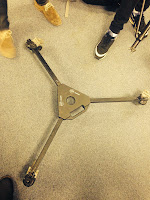The first
scene begins with a low-angle shot from the Bride's perspective which shows the
status and power of the adversary. Non-diegetic western music plays in the
background and works in combination with the fear in her eyes, to create a
tense and slightly solemn vibe.
 The close up
coffin shot shows how restricted her movement is by the coffin by showing her
trying to struggle but unable to. As the stakes are hammered into the coffin,
we are reminded of how helpless the Bride is by her diegetic screams and gasps.
The diagetic sound of the nails represents her heartbeat beating and boosting
the sound creates a distressing mood. The non-diegetic western funeral music
stops with the last diegetic stake, which is an effect known as synchronous.
The close up
coffin shot shows how restricted her movement is by the coffin by showing her
trying to struggle but unable to. As the stakes are hammered into the coffin,
we are reminded of how helpless the Bride is by her diegetic screams and gasps.
The diagetic sound of the nails represents her heartbeat beating and boosting
the sound creates a distressing mood. The non-diegetic western funeral music
stops with the last diegetic stake, which is an effect known as synchronous.
The black and
white colours inside of the box show her discomfort and hostility to being in a
coffin.
This is
followed by a crane shot to re-establish her buried location. When all sounds
stop you hear a van driving away, this shows to the bride that all hope is lost
and her death is impending.
-----------------------------------------------------------------------------------------
The 'mise en
scène' of the resurgence scene is different. The box seems bigger, there is
more colour and it seems brighter. This change of atmosphere signifies hope. It
also gives her more power as the use of a high angle shot from the bottom of
her feet displays.
 The
non-diegetic also changes to a more triumphant, justice like music which is
synchronous with the punching of the coffin. The Bride's facial expression
and bloody knuckles shows how determined
she is to get out of the coffin. With the non-diegetic sounds and the
expressions of encouragement make the viewer want to spur the bride on. Her
heartbeat is also slow as shown by the non-diegetic heartbeat sound that is
synchronous with the music.
The
non-diegetic also changes to a more triumphant, justice like music which is
synchronous with the punching of the coffin. The Bride's facial expression
and bloody knuckles shows how determined
she is to get out of the coffin. With the non-diegetic sounds and the
expressions of encouragement make the viewer want to spur the bride on. Her
heartbeat is also slow as shown by the non-diegetic heartbeat sound that is
synchronous with the music.
After
punching through the wood, the Bride pushes her fist through the solid ground
which is very effective in showing her feeling of success. However, this isn’t
one of Tarantino’s finer moments of directing, as it seems he almost creates a
superhero atmosphere with the sound and the clenched fist of the bride. This
turns the rawness and emotion from when the bride is punching the box, to the
viewers ending the scene in laughter at how unrealistic the escape of the
coffin is.




